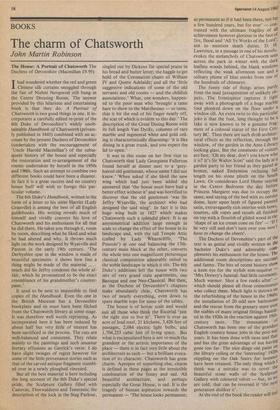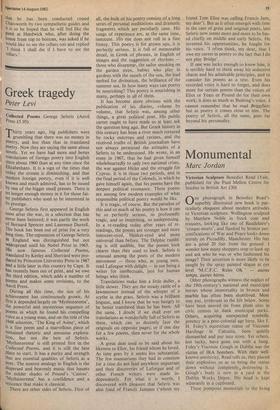BOOKS
The charm of Chatsworth
John Martin Robinson
T had wondered whether the red and green 1 Chinese silk curtains smuggled through the fair of Nizhni Novgorod still hung in the Centre Dressing Room. The answer provided by this hilarious and entertaining book is that they do. A Portrait of Chatsworth is two good things in one. It in- corporates a carefully edited re-print of the 6th Duke of Devonshire's widely unob- tainable Handbook of Chatsworth (private- ly published in 1845) combined with an ac- count by the present Duchess of Devonshire (undertaken with the encouragement of `Uncle Harold Macmillan') of the subse- quent history of the house and especially the restoration and re-arrangement of the rooms undertaken by herself in the 1950s and 1960s. Such an attempt to combine two different books could have been a disaster. In fact it is a great success and no country house buff will wish to forego this par- ticular volume.
The 6th Duke's Handbook, written in the form of a letter to his sister Harriet (Lady Granville) is among the best of all English guidebooks. His writing reveals much of himself and vividly conveys his love of Chatsworth and his enthusiasm for all that he did there. He takes you through it, room by room, describing what he liked and what he had altered and why. It throws much light on the work designed by Wyatville and Paxton in the early 19th century. 'The Derbyshire spar in the window is made of beautiful specimens: it shows how fine a thing might be made of the material .... much did Sir Jeffry condemn the whole af- fair, which he pronounced to be the exact resemblance of his grandmother's counter- pane.'
It used to be next to impossible to find copies of the Handbook. Even the one in the British Museum has a Devonshire bookplate and so must have been filched from the Chatsworth library at some stage. It was therefore well worth reprinting. As incorporated here it has been reduced by about half but very little of interest has been sacrificed in the process. The cuts are well-balanced and consistent. They relate mainly to the paintings and such amateur literary effusions as Garrick's verse. I do have slight twinges of regret however for some of the little provenance stories such as that of the carved antique fragment stumbl- ed over in a newly ploughed vineyard.,
But all the best material is here including the long account of the 6th Duke's special pride, the Sculpture Gallery filled with Canovas, Thorwaldsens and Teneranis; the description of the lock in the Stag Parlour, singled out by Dickens for special praise in his bread and butter letter; the haggle to get hold of the Coronation chairs of William IV and Queen Adelaide; and all the 'little suggestive indications of some of the old servants and old rooms — and the childish associations.' What, one wonders, happen- ed to the poor man who 'brought a tame hare to show to the Marchesino — so tame, that it bit the end of his finger nearly off, the scar of which is evident to this day.' The description of the Great Dining Room with its full length Van Dycks, columns of rare marble and segmental white and gold ceil- ing is characteristically disarming: 'it is like dining in a great trunk, and you expect the lid to open.'
It was in this room on her first visit to Chatsworth that Lady Georgiana Fullerton found herself at dinner next to a 'grey- haired old gentleman, whose name I did not know.' When asked if she liked the new wing which had just been added she answered that 'the house must have had a better effect without it' and was horrified to discover that the old gentleman 'was Sir Jeffry Wyatville, the architect who had designed the said wing'. In fact it is this huge wing built in 1827 which makes Chatsworth such a splendid place. It is an assymmetrical addition large enough in scale to change the effect of the house in its landscape and, with the tall Temple Attic (called by Lady Wharncliffe, 'The Poussin') at one end balancing the 17th- century main block at the other, converts the whole into one magnificent picturesque classical composition admirably suited to the noble landscape in which it sits. The 6th Duke's additions left the house with two sets of very grand state apartments, one Baroque and one Neo-Classical. But then, as the Duchess of Devonshire's chapters make abundantly clear, Chatsworth has two of nearly everything, even down to spare marble tops for some of the tables.
The house is of heroic scale and would suit all those who think the Escorial 'just the right size to live in'. There is over an acre of lead roof, 21 kitchens, 3,426 feet of passages, 2,084 electric light bulbs, and 1,704,233 cubic feet of living space. But what is encapsulated here is not so much the grandeur or the artistic importance of the place — there is in fact very little about the architecture as such — but a brilliant evoca- tion of its character. Chatsworth has great charm. Apropos of something else, charm is defined in these pages as the irresistible combination of the funny and sad. All beautiful architecture, and perhaps especially the Great House, is sad. It is the tragedy of human aspiration towards the permanent — 'The house looks permanent;
as permanent as if it had been there, not for a few hundred years, but for ever' — con- trasted with the ultimate fragility of all achievement however glorious in the face of fire, flood and 'All Ye Works of the Lord', not to mention death duties. D. H. Lawrence, in a passage in one of his novels, evokes the melancholy of Chatsworth seen across the park in winter with the dark leafless woods behind, the blank windows reflecting the weak afternoon sun and a solitary plume of blue smoke from one of the hundreds of chimneys. The funny side of things arises partly from the mad juxtaposition of unlikely ob- jects. The frontispiece captures it right away with a photograph of a huge marble foot plonked down on the floor under a window sill. An extra twist to this particular joke is that the foot, long thought to be a fake is now known to be a genuine frag- ment of a colossal statue of the First Cen- tury BC. Then there are such droll architec- tural effects as the reflection, through the window, of the garden in the Ante-Library looking glass. But the comments of visitors are best. 'Oh my dear, don't you know who it is? It's Sir Walter Scott' said the lady at a garden party to her friend as they gazed at bronze, naked Endymion reclining full length on his stone plinth on the South Lawn. Or considerate Lord Home staying in the Centre Bedroom the day before Princess Margaret was due to occupy the same, and saying of the bed with its outsize dome, layer upon layer of figured painted satin, extravagantly rich interior with bows, rosettes, silk ropes and tassels all finished on top with, a flourish of gilded wood in the 'shape of an ice cream cone on fire' — `1f1 lie very still and don't turn over you won't have to change the sheets'.
The Duchess of Devonshire's part of the text is as genial and vividly written as the bachelor Duke's and admirably coin- plements his enthusiasm for the house. The additional room descriptions are succinct and funny. The bits of recent history show a keen eye for the stylish non-sequitur `Mrs Drewry's funeral. Sad little ceremony' Much warmer. Shot a few rooks after' --- which should please all those connoisseurs who collect them. Much light is thrown on the refurbishing of the house in the 1960s, the installation of 20 odd new bathrooms and the rescue from the granary store over the stables of many original fittings banish- ed in the 1920s in the reaction against 19t1' century taste. The restoration of Chatsworth has been one of the grandest English country house jobs in the post-war years. It has been done with taste and flair and has the great advantage of not having gone too far. The nice dingy old paint On the library ceiling or the 'interesting' 19205 stippling on the Oak Stairs for instance have been retained. The only thing which I think was a mistake was to cover the beautiful stone walls of the Sculpture Gallery with coloured velvet — but, as we are told, that can be reversed if 'the next generation dislikes it'.
At the end of the book the reader will feel
that he has been conducted round Chatsworth by two sympathetic guides and it is to be hoped that he will feel like the guest at Hardwick who, after doing the house from top to bottom, was asked if he would like to see the cellars too and replied I think I shall die if I have to see the cellars.'



































 Previous page
Previous page